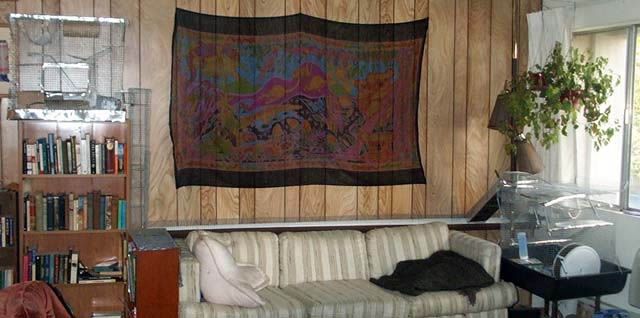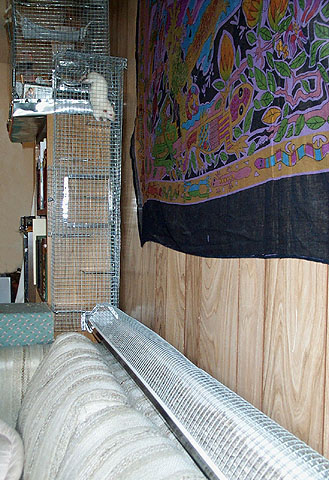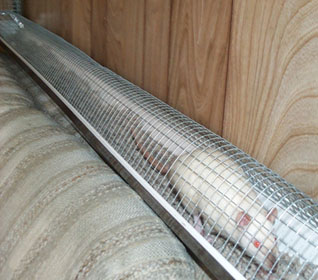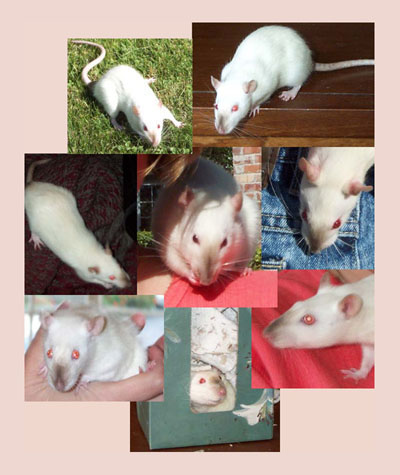I'd wanted to get a pet for several years, and after a great deal of research decided that rats were the pet for me. As a cash-strapped graduate student who lived in an apartment, I was looking for a small and relatively inexpensive pet. Rats sounded more interactive and interesting than hamsters, mice, or guinea pigs, so rats it was. I was concerned about the rat health problems I read about online, particularly mycoplasma, and spent about a year going to different pet stores and checking out their rats, looking for a healthy, non-sneezing litter of rats. I saw many adorable baby rats, but all of them sneezed.
I finally found what I sought at The Pet Factory in Dixon, CA in February, 2000: a group of black and white rats and a few oddly colored beige rats. I watched this cage for over an hour, got the rats out, handled them, and listened to them breathe. The rats were rather skittish, but there were no sneezes! Three of the rats were females: a black and white, and two beiges. The beige rats were cream colored, with smudges of dark brown on their noses and at the bases of their tails. One of them had an attractive pale brown stripe running from the tail base up her back, just like someone has swiped her with a paintbrush of walnut watercolor. Not wanting to be impulsive, I put the rats back in the cage and left the store. I made up my mind at home within a few days, returned to the store on February 9, and scooped up the two beige females.
I named the one with the stripe "Paint" and the other one "Smudge" from their unusual markings. I designed and built a big cage for them, and gradually added more components until it became a habitat that took over half the living room.
|
|
|
Paint and Smudge's cage and "Annex," November 2000. The main cage is the unit on the far right. It can be separated from the rest and turned into a free-standing cage, useful for travel. |
|
|
|
Paint coming down the climbing tower. |
I loved watching them -- they were an undending source of entertainment for me. They climbed, explored, stashed food, chased each other, boxed with each other, and snoozed in a pile. They galloped down a 10-foot runway I'd installed over the back of the couch, flowed up and down a tower, and dug in a dirt box I'd attached to their cage. I spent hours watching them, or reading in the living room next to them while they played together.
I was delighted by how much more behavior they displayed when they had a lot of space. They chose their own favorite sleeping spots, which varied according to temperature. They liked to sleep in the cul-de-sac at the window end of the runway. I was fascinated by this, because it was the most tunnel-like section of the entire cage. In hot weather they snoozed in the upper cage, pushing aside all the bedding so they could lay directly on the cool metal, looking just like a tiny bear rug. They chose special places to cache their food -- discreet corners, inside boxes, under bedding. They had room to interact with each other, and room to get away from each other if they wanted to.
Paint and Smudge were not tame when I got them: both were skittish and struggled while being held. Paint was particularly defensive inside her cage -- she'd lunge and bite unwary fingers that intruded into her space -- but was friendly outside the cage. I spent months taming them, letting them climb between two layers of shirt and carrying them around with me, handling them, giving them treats. I got them out of the cage by lifting their nestbox to a nearby table and waiting till one of them walked out.
Paint gradually became tame. One day in the summer of 2000, Paint settled down on my lap and dozed off with her head resting on my hand. I carried Paint around on my shoulder, in my shirt, or in my pocket. When on my shoulder, Paint learned to lean forward, grab the collar of my shirt with her paw, and dive down my shirt. She rode around inside my shirt, crawling into a sleeve or walking round and round my midriff. Smudge, however, never enjoyed being held... she would ride around in my shirt but didn't enjoy being handled. As she grew older, Paint mellowed delightfully. She'd sit in my arms for an hour, snoozing and bruxing away.
|
|
|
Paint galloping down the runway along the back of the couch. |
Smudge was a dedicated food-cacher. I gave the rats dry kibble in the main cage, and Smudge would take a stack of three in her mouth, slide down the ramp, run along the runway, up the tower, and to the furthest corner of the upper cage, where she would hide her prize. Then she'd run all the way back for another mouthful to cache. She'd run back and back and forth, for half an hour until all the kibble was gone. Paint, in the meantime, would simply sit by the bowl and eat. If the food was exhausted, Paint would amble down the runway (sometimes getting run over by Smudge-on-a-mission), up the tower, and over to Smudge's stash, where she'd park herself to continue her dinner.
Sometimes Smudge used another strategy: she'd take her mouthful of kibble into her wheel, run madly for a few seconds, stop to peek out, see the other rat, then run some more. Finally she'd drop the kibble, return to the bowl for another load and return to the wheel, which now rattled with all the kibbles inside. It was as though she needed to run before hiding the food, but didn't realize she wasn't going anywhere. I called this her alternate reality wheel, as she seemed to think that if she ran long enough in the wheel, she'd get away from Paint and would be able to hide her food in peace. This did her no good... Paint would wait till she was done running, sneak out of the nestbox, reach into the wheel, and grab a kibble.
Paint and Smudge lived for two wonderful years with very few illnesses. Smudge developed a mammary tumor at around 18 months which was uneventfully removed. Around the two year mark, however, both rats developed numerous tumors quite rapidly. Paint developed three mammary tumors and a pituitary tumor which eventually led to her death at nearly two years of age. Smudge developed three mammary tumors, one of which I had removed, but a malignant and inoperable one eventually led to her decline and I had her put to sleep at just over two years.
Aside from their final weeks, Paint and Smudge's lives were remarkably healthy and happy, full of running and exploring and eating and sleeping and playing. Paint and Smudge were my first rats, my beloved companions, and my introduction to the rich and wonderful world of Norway rats.
|
|
|
Collage of photographs of Paint. |
Paint: ca. January 1, 2000 - December 17, 2001
Smudge: ca. January 1, 2000 - January 30, 2002
Cage building instructions:



